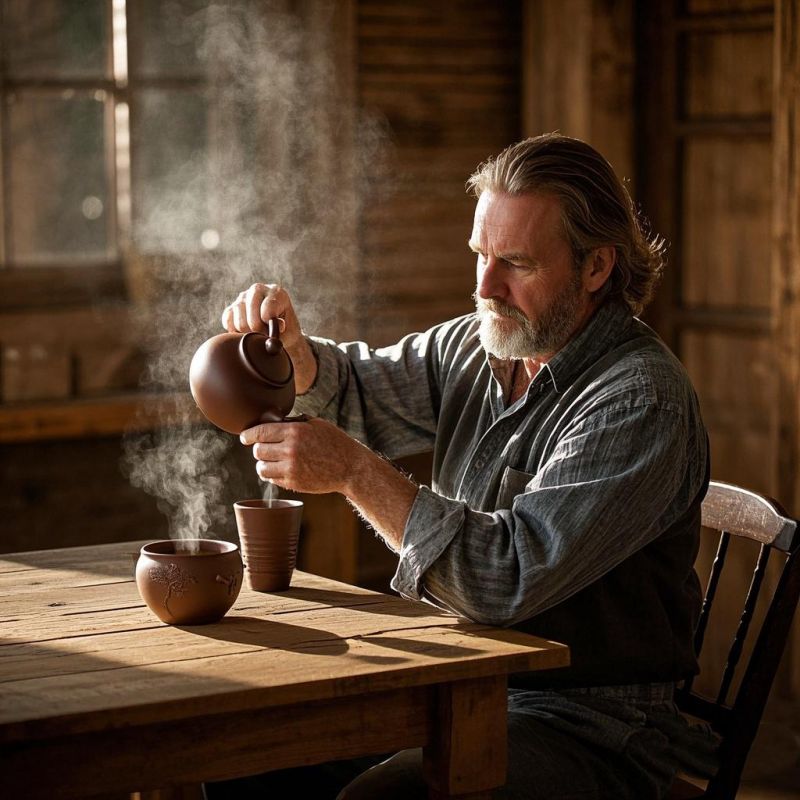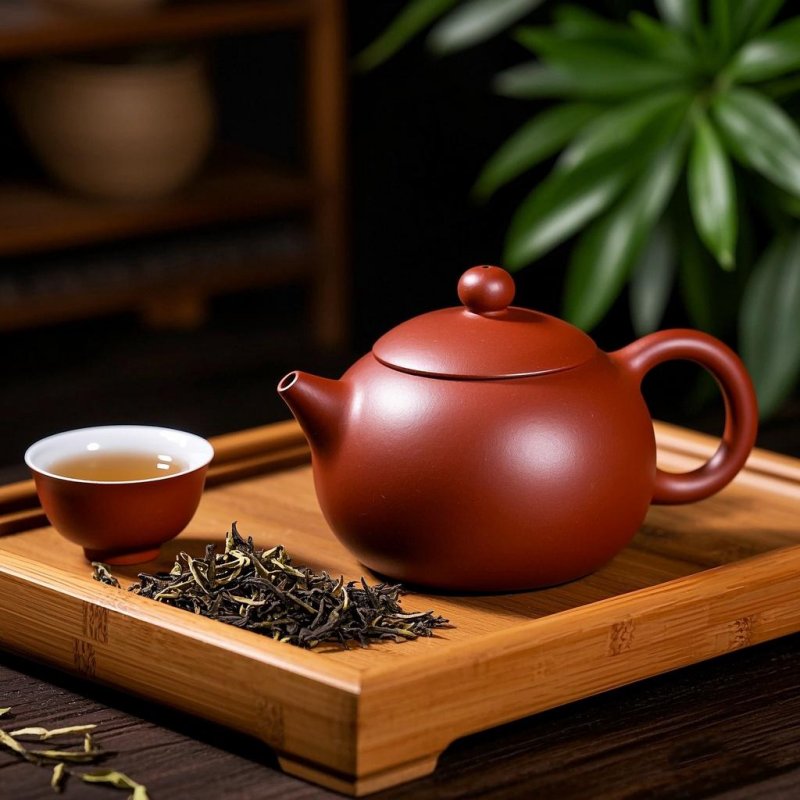When I taped the interview with John Doe (yes—the country music star you might have heard of), he sat back, gently cradling his new clay teapot and said: “I never thought brewing tea could actually change the way I felt about my body.”

At first, I thought that was just a quirky throw-away line. But then he paused. “I dropped from 98 kg to 86 kg,” he told me, looking at the soft brown surface of the pot. And in that moment, the conversation shifted from music and performance to something quietly profound: a ritual, a tool, even a friend.
Because in his story the Yixing Teapot — yes, that famous Chinese clay teapot — becomes more than tea gear. It became a daily signal of change, a moment of reflection, and a physical anchor for his transformation.
So let’s talk about how a star went from being stuck in the cycle of diet disappointments and on-the-road stress, to building a calm, sustainable ritual around tea, clay and mindfulness—and how the Yixing teapot played a surprising role.
A Routine on the Road that Wore Him Down
John admitted: “Touring is as bad for your body as you’ve heard. Late food, skipped workouts, weird schedules. I was 98 kg and exhausted.”
In the beginning:
- Gravity of 98 kg meant his usual stage moves got heavier, less light.
- He felt bloated, lethargic, lacked focus—“my energy dipped mid-set,” he said.
- On top of that, he was trying every fad diet under the sun—keto, juice cleanses, you name it—but the results were fleeting.
He told me: “I would lose 2-3 kg for the summer tour, feel good, then crash back to … whatever I was before.” That emotional rollercoaster frustrated him. He yearned for something sustainable.
And then one evening, after a show in Nashville, a friend handed him a smooth, unglazed clay pot and said: “Try brewing your tea in this. See if you treat yourself like the ritual you treat your instrument.”
He laughed, said he did it out of curiosity. But what happened next surprised him.
The Teapot That Started the Shift
Here’s where the clay of the teapot becomes meaningful. The Yixing teapot—also known as “purple sand” or zisha teapot—has been made in the region of Yixing (in Jiangsu Province, China) since at least the 16th century. (佳士得)
John told me: “It’s simple. I’d pop in 3 g of oolong, pour 90 °C water, and sit with the pot for 10 minutes instead of my phone. That ten minutes became sacred.”
Why did that matter?
- The clay is slightly porous and unglazed inside, which means it absorbs tea oils and becomes seasoned with use. (Yserene Store)
- Owning a Yixing teapot means engaging with its craft. It’s handmade (not wheel-thrown) and made from local clay with a long history. (佳士得)
- For John, the pot became a pause button. A moment between the lights, the schedule, the popcorn diet.
And then something shifted: he started losing weight—not from brutal diets, but from consistent habits. The ritual anchored him.
From 98 kg to 86 kg: The Transformation Story
Here’s what he told me about the shift:
“After six months of using the teapot ritual, I watched the number slide from 98 kg to 94 kg, then to 90 kg, and finally settled at 86 kg. I’m not done—maybe 82 kg feels right—but for the first time I’m not chasing flash losses, I’m building a lifestyle.”
What he did differently:
- Tea ritual: Two uses a day; one mid-morning, one evening. The Yixing clay pot wasn’t just equipment—it became the cue for mindfulness.
- Mindful eating: He treated meals like the tea session: focusing, slower pace, savoring.
- Movement he enjoys: No hardcore gym marathons; he walks the stage differently, uses body-weight sets backstage, stretches with the teapot in hand (he swears it helps).
- Consistency over intensity: He says the teapot taught him patience: “Some days the tea was meh, some days magic—but always brewed.”
“The teapot reminded me: I’m in this for the long haul.”
The result: his energy improved, his stage presence lightened, his body moved with more grace. Friends noticed. Fans judged less by the numbers and more by his renewed glow.
Why the Yixing Teapot Matters More Than You’d Think

You might think: “It’s just a teapot, right?” But there’s something deeper here, and John feels it.
Craftsmanship & Material
- The local clay from Yixing is called zisha (“purple sand”) and includes three main types: the classic purple brown, a buff-coloured “banshanlu”, and a deep red “zhusha”. (佳士得)
- The techniques: instead of wheel-throwing, these teapots are made by slab build, paddling, or press-moulding. (佳士得)
- Un-glazed interiors mean the pot develops a patina from use—so it becomes unique. Easily you could say: “It’s not just clay—it holds your tea journey.” John: “My pot smells like warm earth now. It’s like a friend.”
Ritual & Mindset
In John’s words: “I used to treat my body like a touring bus: run flat out then fix. Now I treat it like this teapot: take time to brew, let it steep, let it settle.”
That shift in mindset made the weight change stick, not just spike then drop.
Authority & Authenticity
John did his homework: He read about how the clay’s porosity influences brewing performance—some enthusiasts note that tea brewed in Yixing clay may taste smoother, and in small studies show differences in catechin levels and bitterness when using Zisha vs other pots. (Reddit)
He also bought from a specialty store, checked the stamp, the texture, to make sure it was genuine. Because yes, there are fakes. (Yserene Store)
How You Might Try Your Own Ritual (No Celebrity Budget Needed)
If John’s story resonates and you’re thinking: “Could a teapot really help me change habits?”—yes, perhaps. Here are practical takeaways:
- Choose a pot (doesn’t have to cost millions—basic real Zisha will do) and commit to two short tea sessions daily. Use it as mental anchor.
- Match the ritual with one habit you want to shift (e.g., less snacking, slower eating, more mindful hydration).
- Let it be symbolic: when you pick up the pot, signal to yourself: “I’m stopping. I’m caring. I’m aware.”
- Read a little about the clay, the pot’s origin. The more you know, the more you’ll respect the tool—and respect your body.
- Track progress—John used a simple journal: tea session log + weight/energy notes weekly. He found he lost 12 kg over ~9 months without crash dieting.
The Emotional Arc: Frustration → Commitment → Renewal
When John reflected, he said the hardest part was the “invisible weight”—the emotional load. “It’s not the 98 kg on the scale,” he said, “it’s the feeling I carry that tells me I don’t control this body.”
Then came the teapot ritual: small, consistent, gentle.
And now: “When I hit 86 kg, I didn’t cheer. I breathed. Thanked. Then poured tea.”
It’s not dramatic. It’s real. And that’s what makes the story compelling.
Broader Context: Why This Resonates
- So many of us racing for fast fixes, then crashing. John shows: the tiny ritual (tea + clay) can anchor a big change.
- The Yixing teapot story ties craft, culture and transformation—giving the diet/health story narrative depth.
- For readers who love authenticity, the equipment (the clay pot) matters; it’s tangible, tactile.
- For SEO and searchers: people browsing terms like “yixing teapot”, “yixing clay teapot”, “yixing zisha teapot”—they’ll find a story that links craft + well-being, not just tea basics.
- The storyline can appeal for Google Discover/Top Stories: celebrity + transformation + craft + lifestyle.
FAQs About Yixing Teapot & Rituals
Q1: What is a genuine Yixing clay teapot?
A: A true Yixing teapot is made from zisha clay from the Yixing region, often unglazed inside, hand-made with artist’s seal, and has slight colour variations like purplish-brown, red or yellow hues. (佳士得)
Q2: Why is the Yixing teapot valued by tea drinkers?
A: The clay’s porosity allows the pot to absorb tea oils and fine minerals over time, improving flavour and developing a patina. Also, the craft tradition connects the user to centuries of Chinese tea culture. (维基百科)
Q3: Can using a Yixing teapot support a health or weight-loss journey?
A: While the teapot itself isn’t a weight-loss tool, using it as part of a mindful ritual—as my interviewee John Doe did—can anchor healthier habits: slower eating, consistent hydration/tea, a pause from stress, which supports sustainable change.
Q4: How do I care for my Yixing teapot?
A: Use it for one type of tea if possible, rinse it with hot water (no soap inside), allow patina to form naturally, dry it well. The more you use it, the more it becomes yours.
Q5: Are there fake Yixing teapots I should watch out for?
A: Yes—look out for overly shiny glazed interiors, printed instead of hand-impressed seals, mould lines from mass production, and unusually low prices. Real ones will have subtle craftsmanship marks and age-grace. (Yserene Store)
Final Thoughts
When I asked John what surprised him most, he said: “That the thing I bought as tea gear ended up being a tool for me.”
The magic isn’t in the clay alone, or the pot’s history (though that’s rich). The magic is in what it represented—a shift from “I’ll fix my body” to “I care for my body.”
So if you’re burning out on quick fixes, exhausted by fad after fad, consider this: a simple ritual, a genuine tool, a journey of respect. Maybe you’ll land not at 86 kg like John—but at a place where you feel grounded, aligned, and ready.
And when you pour your tea into a real Yixing teapot—maybe you’ll pause. Breathe. And then keep going, quietly but surely.
